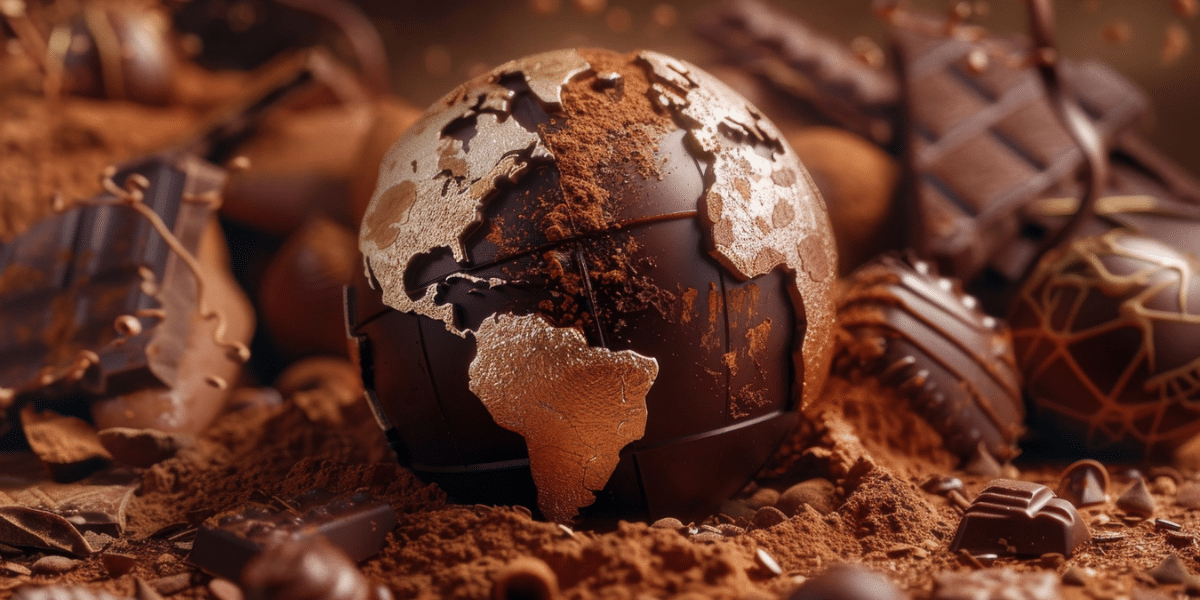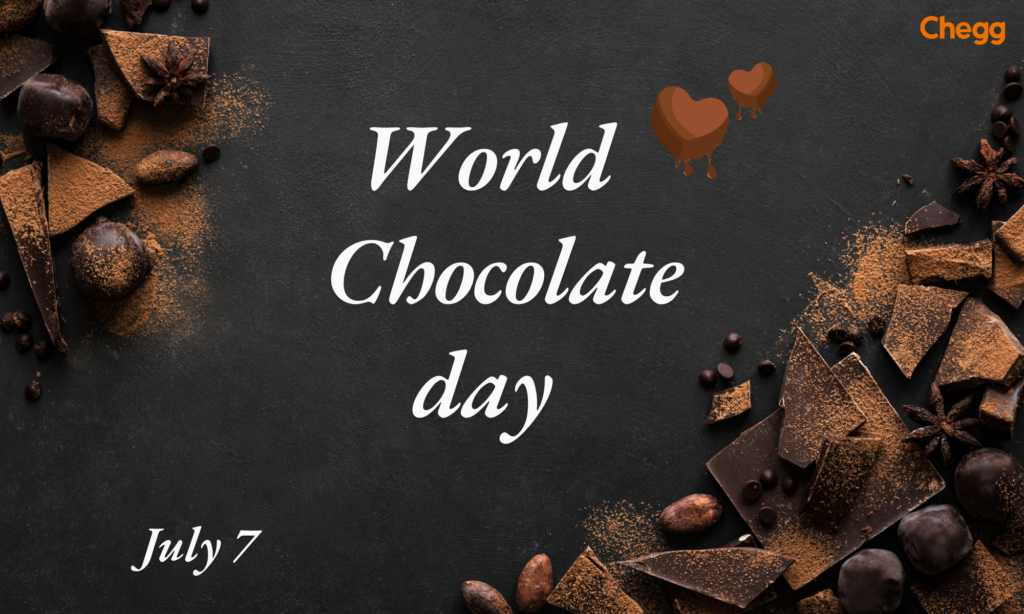
Quick Summary
Table of Contents
World Chocolate Day celebrated globally on July 7, marks the day chocolate was first introduced to Europe in 1550. Officially recognized since 2009, this date celebrates chocolate’s evolution from its ancient New World origins to becoming a universal indulgence. It’s one of several chocolate-centric observances worldwide, including International Chocolate Day on September 13 (USA), National Chocolate Day in the U.S. on October 28, Chocolate Day in Ghana on February 14, and even a Latvian observance on July 11. This day codifies our love affair with chocolate and enriches our cultural connection to it.
Originally made from cacao beans native to Mexico and Central America, chocolate is now enjoyed all over the world. It’s known not just for its flavor, but also for potential health benefits like supporting heart health and soothing sore throats. On World Chocolate Day, people across the globe come together to enjoy their favorite cocoa treats and celebrate the happiness chocolate brings into our lives. So, go ahead treat yourself and share the love with a little bite of chocolate heaven!
The love for chocolate goes beyond age, gender, and cultural differences. It is a popular option for parties, presents, and indulgences. You can easily mould chocolate into complex forms, add it to sauces, pour it over fruits, or infuse it in drinks. Chocolate-based desserts such as cakes, brownies, truffles, and fondue, among others.
Its high cocoa content also makes dark chocolate great as an antioxidative. Some believe it improves heart and brain health. The cacao also aids in boosting the brain’s endorphin synthesis, which intensifies the feelings of enjoyment and fulfilment. People highly value chocolates and give them as gifts on various occasions.
The reality that everyone loves chocolate is the assurance of its potential appeal and capacity to make people happy. The Internet presents many quotes on Chocolate Day that explain the love for chocolates.
People worldwide celebrate Chocolate Day on the 7th of July. In the United States, the twenty-eighth of October is recognized as National Chocolate Day. On this day, one of the best culinary historiography inventions is commended. In India, National Chocolate Day is celebrated on the 9th of February during Valentine’s week.

On this day, the world celebrates Chocolate Day. People also call it International Chocolate Day. In America, they annually observe the 28th of October as National Chocolate Day. It’s an appreciation for one of the world’s great culinary inventions. However, Chocolate Day in India takes place on the 9th of February during Valentine’s week.
World Chocolate Day was established to honor the moment chocolate first graced European shores in 1550. The story begins in the 16th century when Spanish explorers, captivated by the rich cacao traditions of South American tribes, brought this treasured delight back to Europe, forever changing the world’s palate.
With time, the popularity of chocolate among Europeans grew strong enough to move on to other continents. Theobroma cacao trees from Mexico, Central America, and northern South America produce chocolate.
Producers use cocoa liquor to make chocolate, while cocoa powder is used in cakes and cookies, and cocoa butter is used in chocolate bars. There are various ways to celebrate Chocolate Day, such as sharing quotes or thoughts about Chocolate Day, and you can also gift your close ones with delicious chocolate delicacies.
World Chocolate Day is celebrated every year on July 7, marking the day chocolate was first introduced to Europe in 1550. This delightful treat has a rich history, dating back 2,500 years to the Aztec civilization, where cocoa seeds were used as currency and consumed in a bitter liquid form. The transformation into sweet chocolate didn’t occur until the 16th century in Europe, making it a beloved global dessert.
Chocolate comes from the Theobroma Cacao tree, originally found in Mexico, Central, and South America, but today, about 70% of the world’s cacao is grown in Africa. The process of making chocolate involves several steps:
Chocolate also brings health benefits, including:
In India, chocolate was introduced in 1798, but cocoa farming gained pace only by the 1960s–70s, especially in Kerala, Tamil Nadu, and Karnataka. British company Cadbury played a major role in developing India’s chocolate industry. Later, support from Kerala Agricultural University and CAMPCO helped make India a notable cocoa producer. Today, Cadbury and Nestlé dominate the Indian chocolate market.
So on World Chocolate Day, treat yourself to this timeless delight and appreciate the long journey it has taken to become the sweet joy we know today!
| Year | Milestone |
| Beginning of Human History | Chocolate’s journey begins by originating in Mesoamerica. |
| 1500 BC – 300 BC | The Aztecs discovered the joys of drinking chocolate. |
| 300 BC – 500 AD | Mayans incorporated cacao into their culture and rituals. |
| 600 – 1000 AD | Cacao cultivation expanded to South America. |
| 1200s AD | The Aztecs discovered the joys of drinking chocolate. |
| 1500s AD | Cocoa beans make their way to Europe. |
| 1657 | The world’s first chocolate house opened in London. |
| 1765 | The first American chocolate company was established. |
| 1830 | Solid chocolate makes its first appearance. |
| 1868 | Chocolate production scales with mass production. |
| 1875 | The invention of milk chocolate revolutionised the industry. |
| 1895 | Chocolate becomes more affordable for the masses. |
| 1912 | Chocolate bonbons were introduced, becoming a popular treat. |
| 1986 | Single-origin chocolate gained prominence in the market. |
| 2000s | The era of designer chocolates emerged with unique flavours and presentations. |
The cacao tree is the source of cocoa. It grows 20° north and south of the equator and prefers high temperatures, rain, and shade. Farmers pick cacao beans from the oval fruits, or pods, produced by each tree. Each pod contains around 30 to 50 cacao seeds.
Farmers harvest cacao pods, which undergo a vibrant yellow/orange colour transformation, twice a year. After removing them, growers place the seeds in five columns surrounded by a white pulp or pith. In Latin America, over 3,000 years ago, people utilized this pulp, known as baba, to produce fermented cacao wine. The pods allow for continuous harvesting.
Workers clean the beans by hand, leaving the beans to develop flavour. They turn purplish when exposed to light. In Africa, they prepare them for fermentation using the “heap method,” and in Latin America, they use cascading boxes. Both methods cover beans with banana leaves. After 2-9 days, beans take on colour and some “chocolate” flavours.
In the process, artisans carefully dry fermented beans for seven to fourteen days in the blazing sun, using either wooden planks or bamboo mats. After grading, packaging, bundling, and quality checking, exporters exchange the beans on the global market.
The direct trade approach guarantees the highest quality in artisan bean-to-bar chocolates, as exporters send the beans directly to the chocolatier. The processing of the beans is an important part of chocolate making to preserve the taste and quality of the chocolate.
Blending beans with other origins, roasting them at low temperatures, and finely grinding them results in the preparation of cocoa mass, or cocoa liquor. Applying extremely high pressure to the solid nibs in the room extracts cocoa powder and cocoa butter.
Combining cocoa mass, cocoa butter, and sugar may make chocolate. Milk chocolate also contains milk powder, whereas dark chocolate has cocoa mass, butter, and sugar. Producers make white chocolate with cocoa butter, sugar, and milk powder, as it lacks cocoa mass to give it a classic white appearance.
To achieve consistent, pure, and tasty gourmet chocolate, one must use conching. It is a rigorous procedure that involves rolling, kneading, heating, and aeration. As it stirs and smoothes the mixture while being heated, a conch a large agitator defines the final scent and flavour. To achieve fluidity, producers add cocoa butter and soy lecithin, refining the chocolate until it becomes smooth.
In the final processing, producers temper the chocolate and shape it into “pistoles.” Tempering is a process where the cocoa butter reaches its most stable form. Aspiring bakers or chocolate makers can also perform this process at home, providing the chocolate with its “snap,” shiny surface, and smoothness, making it suitable for delivery to a chocolatier.
World Chocolate Day is the perfect excuse to enjoy your favorite chocolate treats guilt-free. Whether it’s a bar, a cake, or a cup of hot cocoa, this day gives you a reason to indulge in chocolate from morning till night. Here’s how you can make the most of it:
Begin your morning with a chocolate-filled breakfast:
For mid-morning or afternoon snacks, grab:
Add a touch of chocolate to your main meals:
Before bed:
Here are 10 cool things you can do to celebrate:
Whether you’re baking, sharing, or simply indulging in your favorite bar, World Chocolate Day is all about enjoying the sweet magic of chocolate and spreading the love!
Read More:-
The presence of chemical components like theobromine, caffeine, and phenylethylamine makes chocolate attractive to many people.
Theobromine stimulates mood, caffeine enhances focus, and phenylethylamine (often called “the love chemical”) makes everyone happy. Chocolate contains serotonin precursors that control appetite, sleep, and mood. After ingesting chocolate, serotonin levels may increase, enhancing happiness. The complexity of its components increases the overall allure of chocolate.
Since ancient times, people have used chocolate in festivities, religious rituals, and romantic gestures. Its rich flavour and texture stimulate the brain’s pleasure regions, providing comfort and emotional well-being. The Industrial Revolution increased the accessibility and affordability of chocolate. It has furthermore participated in important religious and cultural occasions, acting as a symbol of love. A universal delight, chocolate’s persistent appeal transcends space and time.
Cocoa contains flavanols that are rich in anti-inflammatory and antioxidant properties. The flavonoids might enhance vision, lower blood pressure, decrease the probability of developing diabetes, and protect the heart. Further studies are necessary to authenticate these results and establish the potential sustained health benefits of dark chocolate. Even though milk chocolate is high in calories, fat, and added sugar, dark chocolate has some benefits for health. Eating dark chocolate in small quantities, as recommended, is okay if it has a lower quantity of sugar content compared to milk chocolate.
The chemical makeup of chocolate, which activates pleasure areas in the brain, accounts for its widespread appeal. It has long been a component of human festivals, rituals, and displays of affection, playing a crucial role in many different cultures all over the world. Chocolate has a particular place in our hearts since it may provide us comfort and emotional peace. Its rise to prominence from ancient Mesoamerica shows its enduring appeal and flexibility. Chocolate continues to be a beloved friend, across time and boundaries, and brings people from all walks of life together, whether in times of celebration, comfort, or indulgence.
July 7 is celebrated as World Chocolate Day because it marks the date in 1550 when chocolate was believed to have been introduced to Europe. This milestone spread the popularity of chocolate across the world, making it a global treat. The day honors chocolate’s history and its cultural and culinary impact worldwide.
National Chocolate Day, celebrated annually on October 28th, is a day dedicated to one of the world’s most beloved flavors: chocolate. While there are several chocolate-themed holidays throughout the year, October 28th stands out as a day to indulge, enjoy, and appreciate all things chocolate.
International Chocolate Day is celebrated every year on September 13 to honour the birthday of Milton Hershey, the founder of the Hershey Chocolate Company, acknowledging his unparalleled contribution to the popularisation of Chocolate in the US and across the world.
Chocolate Day 2025 Date: The third day of Valentine’s Week, Chocolate Day, is celebrated on February 9 every year, making it a special occasion for lovers to express their affection through the gifting of chocolates.
Chocolate Day 2025 will be celebrated on February 9, as part of Valentine’s Week, and World Chocolate Day 2025 is on July 7, honoring the love for chocolate worldwide.
In India, Chocolate Day is celebrated on February 9 as part of Valentine’s Week. It is different from World Chocolate Day and focuses on gifting chocolates to express love and affection during romantic celebrations.
Swiss chocolate is renowned for its high-quality ingredients, smooth texture, and rich flavor, perfected through traditional craftsmanship, Alpine milk, and innovative conching techniques.
World Chocolate Day is celebrated on July 7, recognizing chocolate’s European arrival.
International Chocolate Day falls on September 13, marking the birthdate of Milton S. Hershey, founder of the Hershey chocolate empire
World Chocolate Day (July 7): Marks chocolate’s introduction to Europe; globally recognized.
International Chocolate Day (September 13): A U.S.-originated observance tied to Milton Hershey’s birthday.
These are separate celebrations both delightful but celebrating different origins and contexts of chocolate’s cultural journey

Authored by, Muskan Gupta
Content Curator
Muskan believes learning should feel like an adventure, not a chore. With years of experience in content creation and strategy, she specializes in educational topics, online earning opportunities, and general knowledge. She enjoys sharing her insights through blogs and articles that inform and inspire her readers. When she’s not writing, you’ll likely find her hopping between bookstores and bakeries, always in search of her next favorite read or treat.
Editor's Recommendations
Chegg India does not ask for money to offer any opportunity with the company. We request you to be vigilant before sharing your personal and financial information with any third party. Beware of fraudulent activities claiming affiliation with our company and promising monetary rewards or benefits. Chegg India shall not be responsible for any losses resulting from such activities.
Chegg India does not ask for money to offer any opportunity with the company. We request you to be vigilant before sharing your personal and financial information with any third party. Beware of fraudulent activities claiming affiliation with our company and promising monetary rewards or benefits. Chegg India shall not be responsible for any losses resulting from such activities.